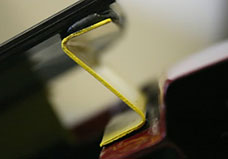Engineers at Cranfield Impact Centre have developed an energy-absorbing device that has the potential to significantly reduce fatalities caused by pedestrian impact with car windscreens.
Current legislation ignores head-impact injury in vehicle design assessment, despite data showing that 30 per cent of fatalities involving pedestrians are caused by head impacts.
The device has been developed during the course of a five-year collaborative research project on pedestrian and cyclist safety, one of seven sub-projects of a €30m (£28m) project on Advanced Protection Systems (APROSYS), sponsored by the European Commission.
The group, led by Cranfield and involving academic specialists and commercial organisations from the UK, Belgium, France, Germany, Italy, the Netherlands, Spain and Sweden, used detailed accident data accumulated from across Western Europe to identify the areas of the windscreen that received the majority of the impacts and those that resulted in fatalities.
The energy-absorbing mounting system, which comprises a flexible Z-shaped section of metal, has been developed for attachment between the main structure of the vehicle and the windscreen. By reducing the apparent stiffness of the windscreen, it allows more energy to be absorbed during a head impact.
Computer simulations demonstrated that the 'Z section' reduced the Head Injury Criterion (HIC) value at the edge of the screen by more than 50 per cent to 828, significantly below the recommended 'safe' value of 1,000. Head impacts at other locations on the windscreen also benefitted.

Roger Hardy, project manager at Cranfield Impact Centre, said: 'This technology can be implemented at minimal cost using the existing attachment technologies and will allow for roadside replacements. The technology will make a valuable contribution towards road safety.'
The results of this research follow the recent news that Euro NCAP, the organisation that assesses the safety of new cars, has introduced an overall car safety rating. The system will now include the Pedestrian Protection rating, among other areas of assessment in the overall rating of a vehicle, challenging manufacturers to produce cars that are safer all round.
The design is currently patent pending.




JLR teams with Allye Energy on portable battery storage
This illustrates the lengths required to operate electric vehicles in some circumstances. It is just as well few electric Range Rovers will go off...